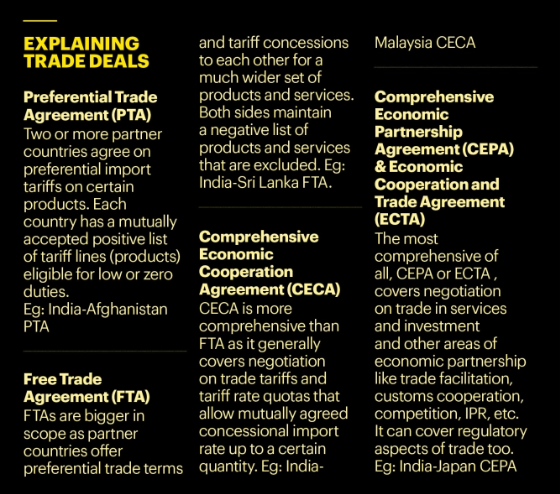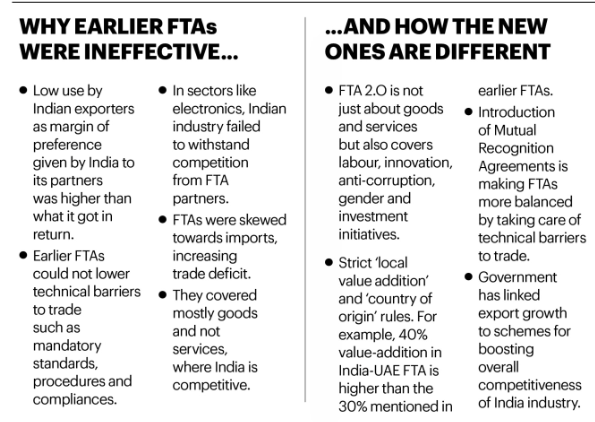Contents
| For 7PM Editorial Archives click HERE → |
Introduction
India-UK FTA is being negotiated under India’s FTA 2.0 approach. The India-UK FTA will serve as a template for India-EU FTA (EU is India’s second-largest trade partner). India’s earlier FTAs with ASEAN and Japan yielded moderate results for India. India has taken its learnings from its earlier approach to FTAs and has come up with a new FTA 2.0 approach.
Under its new FTA 2.0 approach, India has recently signed three trade pacts with Mauritius, UAE and Australia. All the future trade pacts with countries like Canada, Israel, GCC, EU and EFTA will be negotiated under this new approach.
India-UK FTA- Advantages and Challenges summarised in Brief
India-UK FTA negotiations hold importance for both the Indian and the British government. The FTA consists of 26 chapters, out of which 21 chapters have been negotiated. There are some contentious issues, which are delaying the finalisation of the India-UK FTA.
| Advantages of India-UK FTA | Challenges in India-UK FTA |
| Advantage for India 1) Boost to India’s labour-intensive sectors- India’s labour-intensive sector like apparel/textile and gems and jewellery face high tariffs in the UK (Indian Textiles attract 10% tariff). The proposed FTA will bring down the tariffs and help revive India’s labour-intensive sectors. 2) Increase in Indian service exports- The proposed FTA is expected to increase exports of Indian service sectors like IT/ITES, Nursing, education, healthcare, including AYUSH and audio-visual services. 3) Elimination of Non-Tariff barriers for Indian exports- Non-Tariff barriers like testing, certification and pre-shipment inspections have been a major concern for Indian agri-exporters. For ex- Rejection of Indian rice due to pesticide residue. 4) Diversification of Indian trade partners- After India’s exit from RCEP, these FTAs with UK, EU, GCC will help in diversification of India’s trade partners. 5) Strategic Advantage- By strengthening trade bonds with UK, India can seek UK’s support on issues like standoff with China and claim for permanent seat at UNSC. Advantages for UK 1) Push to ‘China-plus one’ strategy- The proposed FTA gives a further push to the strategy of reducing the risks of over-dependence of the British economy on China after the COVID-19 experience. 2) Boost to UK’s beverage and automobile industry- The FTA seeks to lower the Indian tariffs imposed on imported EVs and alcoholic products from UK. (Currently, 70% to 100% duty is imposed by India on imported cars). 3) New partners after Brexit- The search of UK for new trade partners after Brexit is the reason UK is pushing for the deal with India since 2016. 4) Boost to UK’s investment in India- India and the UK are also signing a bilateral investment treaty (BIT) alongside the FTA that can provide an avenue to improve UK’s investments into India. This will be a win-win situation for both countries. | 1) Reaching an agreement on the Rules of Origin (ROO)- ROO determines the national source of a product. India is pushing for strict Rules of origin. For ex- India fears dumping of European alcoholic drinks like gin, vodka and Irish whiskey, into India via UK. 2) Work permit for Indian service sector workforce- After Brexit, UK has adopted a strict policy on granting work permits to foreigners. India is pushing for relaxation in the work permit policy. 3) Carbon tax- UK is looking to impose carbon tax on metal imports on lines of EU’s carbon border adjustment mechanism (CBAM). This tax will hurt Indian manufacturing sector’s exports such as cement, iron and steel and glass sector. 4) Intellectual property rights- Strong IPR regime is being pushed by UK. For ex- UK which is a leader in life science innovation, is pushing for stronger IPR regime in the medical sector while this is being opposed by India which is the largest manufacturer of generic drugs in the world. 5) Digital Trade/Cross Border Data Flow – India is yet to finalize its domestic laws on digital trade and data protection. Hence, it is exercising caution in making commitments in the proposed FTA. 6) WTO’s MFN violation- Any interim and incomplete FTA would attract violation of the Most Favoured Nation (MFN) principles of the WTO. 7) Global Value Chain (GVC)- Discussions on the India-UK FTA are going in details to address complexities related to global value chains. India is negotiating hard for outcomes, which favour its ambition to become an alternative to China in the GVC. 8) Domestic political compulsions- India-UK FTA also faces challenges due to the growing political negativity towards India within Britain. 9) India’s concerns of protection of its domestic industries- India is also concerned to protect its domestic alcohol bottling industry, which will face tremendous competition from the UK beverage companies. |
What is FTA? What were the failures of India’s old FTA which led to India’s new FTA 2.0 approach?
Free Trade Agreements- FTAs are arrangements between two or more countries or trading blocs that agree to reduce or eliminate customs, tariff and non tariff barriers on substantial trade between them.
Trade deals are of Different types which are explained below

| Read More- What are free trade agreements |
Failures/Challenges of India’s Earlier FTAs which led to adoption of new FTA 2.0 approach
1. Uneven distribution of gains- The margin of preference (actual tariff cuts) given by India to its FTA partners in the old FTAs were higher than the margin of preference given by partner countries.
2. India’s low FTA utilisation- India’s FTA utilisation remained very low at around 25 per cent. On the other hand, developed countries utilise the FTAs to the maximum(~ 70–80 per cent).
3. Increase in Indian imports to the detriment of Indian domestic industries- The earlier signed FTAs, resulted in the increase of import of FTA partner’s goods in India to the detriment of Indian domestic markets. For ex- Japan and ASEAN countries, exports to India increased tremendously while Indian export to them did not increase commensurately.(In the period between 2017 and 2022, India’s exports to its FTA partners increased by 31 per cent, while its imports increased by 82 per cent).
4. Misuse of Rules of Origin- The earlier negotiated FTAs had relaxed Rules of Origin(ROO) provisions, which were misused by the FTA partners to dump their products in Indian market. For ex- Chinese electronics via ASEAN FTA. However, the complexity of certification requirements of ROO, under these FTAs hindered India’s ability to streamline processes for its exporters
5. Lack of adequate industry and stakeholder consultation- During the previous FTA negotiations, Negotiators failed to involve representatives from relevant industries, businesses and associations. This led to market access being granted to FTA partners without considering critical views and concerns from domestic industries.
6. Stringent Non-Tariff barrier provisions in the Old FTAs- Previous FTA negotiation focus of India was more on Tariff barrier reduction. The non-tariff barriers provisions were not negotiated properly, which led to its mis utilisation against India. For ex- Indian exports have remained stagnant due to Japan’s high import standards, despite India-Japan FTA.
7. Disparity in the performance of the manufacturing sectors in India and its FTA partner economies- South Korea and ASEAN’s manufacturing sectors outperformed India’s in critical industries such as electronics, automobiles, leather and textile products as their industries were more competitive than the Indian counterparts. This led to a surge in Indian imports due to the FTA between South-Korea and ASEAN.
8. Lack of Government’s efforts to popularise FTAs among industry stakeholders- Limited outreach activities and inadequate marketing to create awareness about the benefits of the FTAs resulted in the underutilisation of these agreements.
9. Failure of India to take advantage of its service sector- India failed to take advantange of its strong service sector capability by failing to include service sector in some of the earlier FTAs.
Difference between the Earlier FTAs and the FTA 2.0
India has recognised the flaws in its earlier FTAs, with the Indian Minister of Commerce and Industry Piyush Goyal acknowledged that earlier FTAs were poorly conceived. The government initiated the review, and came up with a new FTA 2.0 policy.

Conclusion and Way Forward
India’s Comprehensive Economic Partnership Agreement (CEPA) with the United Arab Emirates and the Economic Cooperation and Trade Agreement (ECTA) with Australia are both part of India’s FTA 2.0 approach. India’s exports to both countries have shown a significant increase just a few months after the conclusion of the CEPA, and remarkable FTA utilisation statistics have also been reported.
However, we should not be buoyed by the short term results. We must focus on taking the following steps to use the FTAs 2.0 to our advantage.
1. Development of Trade infrastructure- Govt must take efforts to give a boost to trade infrastructure, set up fast track dispute settlement mechanism and digitise trade procedures.
2. Increase global competitiveness of Domestic industries- Increased competitiveness of Indian industries will help us increase exports to FTA partners and achieve our target of $5 trillion economy.
3. Regular industry consultation and use of data analytics- The regular feedback of industrial bodies like CII, FICCI and creation of data analytics division in the commerce ministry to regularly analyse the trade data to take corrective measures.
4. Inclusion of new Paradigms of international trade- Trade in services, e-commerce, labour, climate/environment, digital trade, public procurement have become central issues in international trade. Government must be prepared to adjust to this new paradigm in FTA 2.0 rather than avoiding these issues. Like for example- Foreign Trade Policy for digital goods.
4. WTO Plurilateral Negotiations- India could further increase its exports by participating in the major plurilateral negotiations on services, environmental goods, and government procurement now taking place at the WTO.
| Read More- The Indian Express UPSC Syllabus- GS 3- Indian Economy and Issues related to Growth |
Discover more from Free UPSC IAS Preparation Syllabus and Materials For Aspirants
Subscribe to get the latest posts sent to your email.







